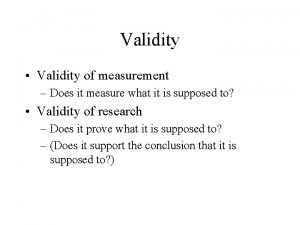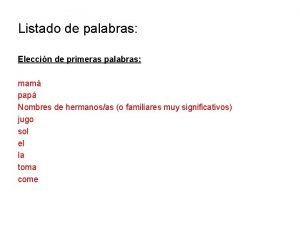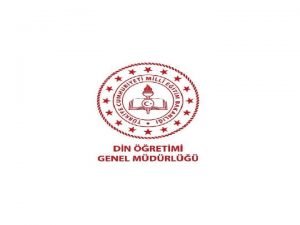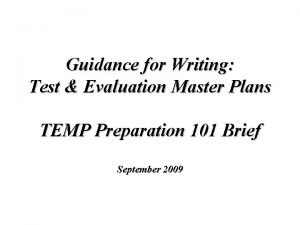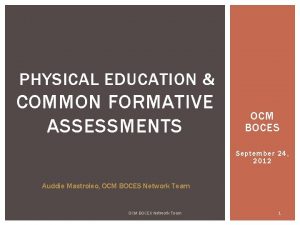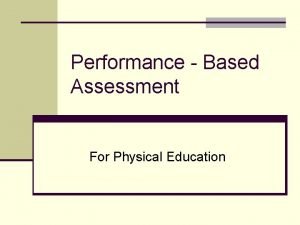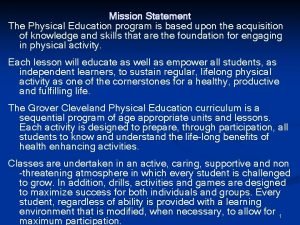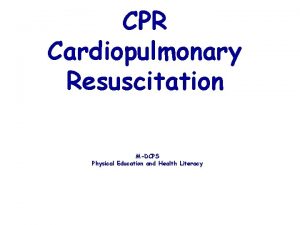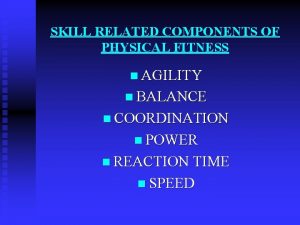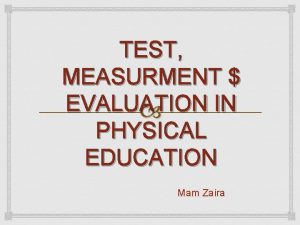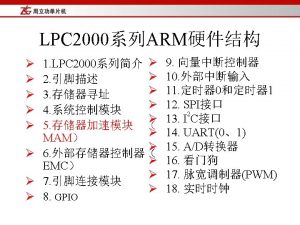TEST MEASURMENT EVALUATION IN PHYSICAL EDUCATION Mam Zaira












































![Physical Fitness Index: • By using Modified Harvard Step Test (HST) [1]: The test Physical Fitness Index: • By using Modified Harvard Step Test (HST) [1]: The test](https://slidetodoc.com/presentation_image_h/1ce3e2996e4996a33333d7f63e541d47/image-45.jpg)
















































- Slides: 93

TEST, MEASURMENT $ EVALUATION IN PHYSICAL EDUCATION Mam Zaira

Content 1. 2. 3. 4. 5. 6. Evaluation $ administration of tests Basic statistics Measurement of physical fitness Cardiovascular fitness Rating scales in physical education Measurement of specific sport skills

Evaluation & Administration of tests

1. Criteria for selecting appropriate test The two major criteria for selecting tests are reliability and validity no matter what type of test one uses, it should be reliable and valid. Reliability means that the test yield similar results when it is repeated over a short period of time or when different form is used.

Validity: • Validity refers to the tests ability to measure what it is supposed to measure. A beep-test is meant to test an athlete's cardiovascular endurance. It is valid, because it gives an accurate prediction of an athlete's V 02 max test, done in a laboratory would be a more valid test.

Types of validity Ø Construct Validity: Evaluates whether a measurement tool really represents the things we are interested in measuring. It's central to establishing the overall validity of a method. Ø Content Validity: When it comes to developing measurement tools such as intelligences tests, survey, and self-report assessment, validity is important. Ø Face Validity: Considers how suitable the content of a test seems to be on the surface. It's similar to content validity, but face validity is a more informal and subjective assessment. Ø Criterion Validity: Evaluates how closely the results of your test correspond to the results of a different test.

Reliability: • Reliability refers to the reproducibility of values of a test, assay or other measurement in repeated trials on the same individuals. …. . For many measurements in sports medicine and science, the typical error is best expressed as a coefficient of variation (percentage of the mean)

Types of reliability: ØInter-Rater or Inter-Observer Reliability: used to assess the degree to which different raters/observers give consistent estimates of the same phenomenon. ØTest-Retest Reliability: Used to assess the consistency of a measure from one time to another.

ØParallel-Forms Reliability: used to assess the consistency of the result of two tests constructed in the same way form the same content domain. ØInternal Consistency Reliability: Used to assess the consistency of results across items within a test.

2 Pre test responsibilities: • Pretest evaluation is conducted to access the physical & mental health of athletes before they undergo training or join a sports competition.

Procedure of pre test evaluation: • For any testing session there are many important steps to ensure the session to run smoothly & safely , & that the information is collected is accurate. Here there is a list of many steps that should be consider: • Prepare equipment's • Pre test measures • Prepare athletes

Prepare equipment's: • Prepare forms for recording results • Check that all equipment is at hand & functional • Calibrate the equipment if required. Pre test measures: • Record test condition: date weather surface etc. • Record basic subject information: name, age, height, body weight • Obtain: heart rate, blood pressure etc.

Prepare athletes: • Remove restrictive jewelry, watches, bracelets, or hanging hearings that may get caught with in equipment's • Explain the test procedure to the subject.

Importance of pre sports evaluation: • The specific purposes include the following: • To identify athlete's at the risk of sudden death. • To identify medical conditions that may require further evaluation & treatment before participation. • To identify orthopedic conditions, include physical therapy before participation. • To satisfy legal requirements of athletic governing board.

3 Duties & responsibilities during test: • In the test planning and preparation phases of the testing, testers should review and contribute to test plans, as well as analyzing, reviewing and assessing requirements and design specifications. • They may be involved in or even be the primary people identifying test conditions and creating test designs, test cases, test procedure specifications and test data, and may automate or help to systematize the tests. • They often set up the test environments or assist system administration and network management staff in doing so.

• As test execution begins, the number of testers often increases, starting with the work required to implement tests in the test environment. • Testers execute and log the tests, evaluate the results and document problems found. • They monitor the testing and the test environment, often using tools for this task, and often gather performance metrics.

4. Post test evaluation: • Post test is based on the results, a program will be designed to meet goals & needs • The results are access progress of design, performance, supportability, etc.

Functions of post test evaluation: • • It identifies the very weak students. It identifies the strongest students in the class It identifies the topic which students already know It identifies the topic which students don’t know

After the test –it is an inappropriate & unethical to: • • • Make inaccurate reports Unsubstained claims Inappropriate interpretations False & miss leading statements Erase or change students answers

BASIC STATISTICS

Definition of standard deviation? A quantity expressing by how much the members of a group differ from the mean value for the group. The standard deviation is given by the formula: s means 'standard deviation'. Now, subtract the mean individually from each of the numbers given and square the result. This is equivalent to the (x )² step. For example The mean of the following two is the same: 15, 15, 14, 16 and 2, 7, 14, 22, 30.

Basic statistics Standard deviation In case of individual observations, Standard Deviation can be computed in any of the two ways: 1. Take the deviation of the items from the actual mean key points 2. Take the deviation of the item from the assumed mean In case of a discrete series, any of the following methods can be used to calculate Standard Deviation: 1. Actual mean method 2. Assumed mean method 3. Step deviation method

What does standard deviation tells you ? Standard deviation is a number used to tell how measurements for a group are spread out from the average (mean), or expected value. A low standard deviation means that most of the numbers are close to the average. A high standard deviation means that the numbers are more spread out.

Standard deviation Why standard deviation is important? The main and most important purpose of standard deviation is to understand how spread out a data set is. Advantages of Standard Deviation: The standard deviation is the best measure of variation. It is based on every item of the distribution. You can do algebraic operation and is less affected by fluctuations of sampling than most other measures of dispersion.

Normal probability curve What is probability? Probability is the likelihood or chance of an event occurring. . The probability of something which is certain to happen is 1. The probability of something which is impossible to happen is 0. Normal probability curve A normal curve is a bell shaped curve which shows the probability distribution of a continuous random variable. . It shows a symmetric distribution as 50% of the data set lies on the left side of the mean and 50% of the data set lies on the right side of the mean

Properties of normal probability curve? These are some properties of normal probability curve as following: Ø Ø Ø The normal curve is symmetrical The normal curve is uni modal Mean, median and mode coincide The maximum ordinate occurs at the center The normal curve is asymptotic to the X-axis The height of the curve declines symmetrically Normal curve is a smooth curve: The normal curve is a mathematical model in behavioral sciences The normal curve is bilateral Greater percentage of cases at the middle of the distribution The scale of X-axis in normal curve is generalized by Z deviates The equation of the normal probability curve reads

What is the normal curve in psychology? Normal Curve. A frequency curve where most occurrences take place in the middle of the distribution and taper off on either side. Normal curves are also called bell shaped curves. A “true” normal curve is when all measures of central tendency occur at the highest point in the curve. Normal Probability Curve’. Thus the “graph of the probability density function of the normal distribution is a continuous bell shaped curve, symmetrical about the mean” is called normal probability curve. ‘

In statistics it is important because: (а) It is the distribution of many naturally occurring variables, such as intelligence of 8 th grade students, height of the 10 th grade students etc (b) The distribution of the means of samples drawn from most parent populations is normal or approximately so when the samples are sufficiently large. Therefore normal curve has great significance in social sciences and behavioural sciences. In behavioural measurement most of the aspects approximates to the normal distribution. So that Nor mal Probability Curve or most popularly known as NPC is used as a reference curve. In order to understand the utility of the NPC we must have to understand the properties of the NPC.

Standard Scores ( Z. scores T. scores ) Standard score is a set of scores with the same mean and standard deviation. By converting raw scores into a standard score, it allows the scores to be compared. . By using the standard deviation and statistical procedures, it is possible to determine a percentile score for a If a z score is equal to 0, it is on the mean. If a Z Score is equal to +1, it is 1 Standard Deviation above the mean. If a z score is equal to +2, it is 2 Standard Deviations above the mean. . This means that raw score of 98% is pretty darn good relative to the rest of the students in your class.

Types of Standardized Test Scores Z Scores: These scores are scaled on a number line ranging from 4 to 4. T Scores: These scores range in intervals of 10 from 10 to 90 points. What is a standard age score? Standard Age Score (SAS) is a normalized standard score, with a mean (average) of 100. Standard Age Scores of 89 111 are all within the average range. For example: A student with a SAS of 100 on the Verbal Battery has the rate and level of development of verbal reasoning skills that are typical for his/her age group. Stanine : Score The stanine scale is also called the standard nine scale A Word From Very well What is the average standard score? Scaled scores are often combined to form standard scores. The average range for a scaled score is 8 10, and 50% of all children at a given age will fall in this range. T scores are another type of standardized score, where 50 is average

MEASUREMENT OF PHYSICAL FITNESS

INTRODUCTION • Physical activity is essential for the development of wholesome personality of a child which would depend upon the opportunities provided for wholesome development of physical & mental, spiritual aspects & social. Hence a well organize and properly administered physical education programmed for school very essential.

• Over a decades, the society in general has realized the need for keeping fit & healthy through organized physical activity program. • Physical activity throughout the ages has been acclaimed for health & recreation.

Physical fitness • Physical fitness is your ability to carryout task without no fatigue. • The capacity to carry out everyday activities without excessive fatigue & with enough energy in reserve force emergencies.

• Physical fitness is one’s ability to execute daily activities with optimal performance, endurance & strength with the management of disease, fatigue, & stress & reduced sedentary behavior.

• Physical fitness is one’s ability to execute daily activities with optimal performance, endurance & strength with the management of disease, fatigue, & stress & reduced sedentary behavior.

Components of physical fitness: • There are five health-related physical components 1) Cardiovascular Endurance 2) Muscular Endurance 3) Muscular Strength 4) Flexibility 5) Body Composition

Cardiovascular Endurance • Cardiovascular endurance is also referred to as aerobic fitness, and is a measure of the athlete’s ability to continue with exercise, which places demands on the circulatory and respiratory system over a prolonged period of time. Such as: running, walking, cycling, and swimming.

Muscular Strength • Muscular strength is the maximal force that can be applied against a resistance. It could be measured by the largest weight a person could lift or the largest body they could push or pull. Strength is important for both man and women. Strength may be broken down into three types: 1. Maximum Strength 2. Elastic Strength 3. Strength endurance

Muscular Endurance • Muscular endurance differs from muscular strength in that it is a measure of a person’s ability to repeatedly apply maximal force, for example in a series of push-ups, over a period of time. Muscular endurance the ability to use voluntary muscles many times without getting tried.

Flexibility • Flexibility is the range of motion in a joint or group of joints or the ability to move joints effectively through a complete range of motion. Flexibility training includes stretching exercises to lengthen the muscles and may include activities like yoga or Tai Chi.

Body Composition • Body composition is the assess your health and proportion of fat or non fat fitness level. mass in your body. A healthy body composition is one that includes a lower percentage of body fat and a higher percentage of non-fat mass, which includes muscles, bones, and organs. Knowing your body composition can help you

PHYSICAL FITNESS INDEX: • Physical Fitness Index (PFI) is measured by Harvard's step test. The Harvard Step Test is a type of cardiac stress test for detecting or diagnosing cardiovascular disease. It also is a good measurement of fitness and a person's ability to recover after a strenuous exercise.

Objectives of Physical Fitness Index: • The Physical Fitness index measures the physical fitness for Muscular work & the ability to recover from the work. The present study was undertaken to assess the physical fitness index using Modified Harvard Step Test in young adult in the age group of 17 to 24 years with varying degree of physical activities.
![Physical Fitness Index By using Modified Harvard Step Test HST 1 The test Physical Fitness Index: • By using Modified Harvard Step Test (HST) [1]: The test](https://slidetodoc.com/presentation_image_h/1ce3e2996e4996a33333d7f63e541d47/image-45.jpg)
Physical Fitness Index: • By using Modified Harvard Step Test (HST) [1]: The test was done on Modified Harvard Steps of 33 cm height. PFI was calculated by using following formula. Physical fitness Index (%) (PFI %) [9] PFI = Duration of exercise in seconds x 100 2(pulse 1+2+3)

Procedure: • The Subject was advised to step upon the modified Harvard steps of 33 cm height once every two seconds (30 per minute) for 5 minutes, a total of 150 steps. At one, three and five minutes during the test, pulse rate was re-corded as (a) PR 1 (Pulse Rate 1) - 1 min after exercise (b) PR 2 (Pulse Rate 2) - 3 min after exercise. (c) PR 3 (Pulse Rate 3) - 5 min after exercise.

MEASUREMENT OF MOTOR FITNESS

Motor Fitness • Motor Fitness is a term that describes an athlete's ability to perform effectively during sports or other physical activities. • Improving this form of fitness is an indirect result of training in any of these attributes.

Components of fitness related to motor skills • Agility • Balance • Coordination • Power • Speed • Reaction time Motor skills improve the practice and all six components determine your level of athletic ability.

Agility • It is the capacity to change course, controlling the direction and position of your body while maintaining your momentum. Measurement • Shuttle run test • zig-zag run test

Balance • It is the ability to stabilize your body, whether standing still or maintaining motion. Ice skating, skiing and bicycle riding are balance exercises. Types Of Balance There are two types of balance: 1. Static Balance: refers to the ability of a stationary object to its balance. 2. Dynamic Balance: deals with stability in motion.

Coordination • Coordination describes the synchronization of senese and body parts in a way that enhances motor skills. • the ability to use different parts of the body together smoothly and efficiently.

Speed • Speed is the ability to move quickly across the ground or move limbs rapidly to grab or throw. Movement speed requires good strength and power.

Power • The ability to exert maximum muscular contraction instantly in an explosive burst of movements. • The capacity or ability to direct or influence the behaviour of others or the course of events.

Reaction Time • Reaction time measures how swiftly you interpret and then react to expected and unexpected events happening around you.

Cardiovascular Fitness

Cardiovascular fitness is the ability of the heart and lungs to supply oxygen-rich blood to the working muscle tissues and the ability of the muscles to use oxygen to produce energy for movement. This type of fitness is a health-related component of physical fitness that is brought about by sustained physical activity. A person's ability to deliver oxygen to the working muscles is affected by many physiological parameters, including heart rate, stroke volume, cardiac output, and maximal oxygen consumption.

What is the example of cardiovascular fitness Activities like walking, jogging, running, cycling, swimming, aerobics, rowing, stair climbing, hiking, cross country skiing and many types of dancing are pure aerobic activities. Sports such as soccer, basketball, squash and tennis may also improve your cardiovascular fitness.

Why cardiovascular fitness is important Of the 11 part of fitness, cardio respiratory endurance is the most important because it gives you many health and wellness benefits, including a chance for a longer life. It requires : A strong heart A healthy lungs and A clear blood vessels to supply your large muscles with oxygen.

Measurement of Cardiovascular Fitness • How cardiovascular fitness is measured? VO 2 max is considered to be the most valid measure of cardio respiratory fitness. It measures the capacity of the heart, lungs, and blood to transport oxygen to the working muscles, and measures the utilization of oxygen by the muscles during exercise. One way to test is using the Rockport Fitness test. The purpose of this test is to walk as fast as possible for 1 mile. After you have completed the mile, immediately take your pulse rate. Note the time it took to complete the mile. You will also need to know your body weight for the VO 2 max calculation.

• To measure maximal aerobic capacity, an exercise physiologist or physician use a VO 2 test, • The individual is typically connected to a respirometer to measure oxygen consumption. • The higher to measured cardio respiratory endurance level, the more oxygen has been transported to and used by exercising muscles.

There are types or field test of cardiovascular fitness: • Rockport walking test • Harvard Step test • Astrand rhyming bike test • 12 -minut run test • 12 -minut swim test

• Tools to measure the cardiovascular fitness: • Your resting heart rate is how many time your heart beats in 1 minute while you are resting. • Resting heart rates for teenagers may range between 60 and 90 beats per minute.

RATING SCALES IN PHYSICAL EDUCATION

Construction of Rating Scales Introduction: Rating scales are simply a set of answers to a questions that allow respondents to provide a rating. An example is shown below: How would you rate the supermarket you use most often in terms of value for money? § Very good § Quite good § Not very good § Not at all good

1. Should a “Not sure” answer be included? In the example above I haven’t included a “Not sure” option. In this instance respondents are being asked to rate the supermarket they use most often. Assuming they have already been asked their most often used supermarket they should have an opinion. Not including a “Not sure” takes away the easy option and forces respondents to think and judgment. How would you rate Aldi in terms of value for money? § Very good Quite good § Not very good Not sure § Not at all good

2. Should I use words or numbers? Some researchers use numeric rather than worded scales. An alternative way to ask for rating about value for money of the supermarket you use most often is shown below: How would you rate the value for money provided by the supermarket you use most often on a scale of 1 to 10 where 10 is excellent and 1 not at all good? § 1 § 2 § 3 § 4 § 5

Cont. … 6 § 7 § 8 § 9 § 10 Asking respondents to give a mark out of 10 is a popular way to ask question. The ability to report a mean score out 10 seems to have widespread appeal. §

Rules for the Use of Rating Scale Introduction: § Rating is the assessment of a person by another person. Rating is term applied to expression of opinion or judgment regarding some situation, object character. Opinions are usually expressed on a scale or value. Rating techniques are devices by which such judgments may be quantified. § “Rate scale records how much or how well it happened. Quantitative and qualitative terms will be used.

Uses of Rating Scale The uses may be classified into two evaluation areas: 1) Product evaluation 2) Personal Social development §

Product Evaluation: When pupil performance results in some type of product, it is frequently more desirable to judge the product rather than the performance. The ability to make a model of sanitary well, for example, is best evaluation by judging the quality of the product itself. Little is to be evaluated by observing the student’s performance.

Evaluating personal-social development: One of the most common uses of rating scales in the schools is rating various aspects of personal-social development. Rating personal social characteristics is quite different from product evaluation. When judging products the rating are usually made during or immediately after a period of observation. In contrast, ratings of personal-social development are typically obtained at periodic intervals and represent a kind of summary of teacher’s general impression.

Measurement of specific sport sills

Badminton • • • Introduction History of badminton Basic rules Regulations Equipment Officials

Introduction Badminton is a racket sports played by either two opposing players (singles) or two opposing pairs (doubles), who take position on opposite halves of a rectangular court that is divided by a net. Since 1992, badminton has been Olympic sport with five events: men’s and women’s singles, men’s and women’s doubles, and mixed doubles.

History of badminton Badminton came from a game called ‘Poona’ in India during the 18 th century. The international badminton federation (IBF) (now known as badminton world federation (BWF) was established in 1934 and ever since it has been developing this sport.

Basics Rules A match can be played with either 1 or 2 players per each team (singles and doubles). To score a point the shuttle must land inside the parameter of the opponent’s side of the court. If any part of the players body or racket touches the net then there opponent gets the points. If the score reaches 20 all then the game continues until one side gains a two points lead (such as 24 22) up to maximum of 30 points (30 29) is a winning score).

Regulation The court must be 6. 1 m by 13. 4 m. The net must be 1. 55 m off the ground In badminton there are no second servers. so if you don’t get your serve right then the opponents win the point. A serve must be underarm and below the player waist. The game only stop of 2 rest periods, one after the game for 90 seconds, and the again after the seconds games for 5 minutes

Equipment, Officials EQUIPMENT Racket Shuttle Shoes Net Court OFFICIALS (One)Umpire (One)Referee (One)Service judge (8/10)Line judge

Volley ball

History On February 9, 1895, in Holyoke, Massachusetts (USA), William G. Morgan, The federation international volleyball (FIVB) was founded in 1947, and the first world championships were held in 1949 for men and 1952 for women. The sport was officially included in the program for the 1964 summer Olympics.

THE GAME: It is a game of two teams of six players separated by a net. COURT AND POSITION: The court is divided in 2 equal parts. In one part, there are Serving zone, Defense zone, and Attack zone. POSITION: the players rotated like, clockwise

COURT DIMENSIONS: Length: 18 meters Width: 9 meters Net height: Men (2. 43) Women’s (2. 24) meters. Ball: Circumference (65 to 67 cm) Weight: (260 to 280 grams)

Rules in volley ball There a lot of rules, but the most important are; The players can’t touch the net. A single person can’t touch the ball two times consecutively. The team is only allowed three touches. The serve must start outside the court. Blocking a serve isn’t allowed. The result of a violation is a point for the opponent. Serving out of order. Failure to serve the ball over the net successfully

Faults A few of the most common faults include: Causing the ball to touch the ground or floor outside the opponent’s court or without first passing over the net. Catching and throwing the ball. Double hit; two consecutive contacts with the ball made by the. Four consecutive contacts with the ball made by the same team; Net foul; touching the net during play. Foot foul: the foot crosses over the boundary line when serving same player

Officials Scorers Line judges First referee Second referee

Tennis

History Tennis is a racket sports that can be played individually against a single opponent (singles) or between two teams of two players each (doubles). Each player uses a tennis racket that is strung with cord to strike a hollow rubber ball covered with felt over or around a net and into the opponent’s court

In traditional tennis, it takes 4 points to win a game, 6 games to win a set and 2 sets to win a match. The first player to win a point has a score of 15(or one); the other player who has no points has a score of love (or zero). The server’s score is always said first. So 15 love means the server’s score is 15 and the receiver’s is 0. If the server wins the next point, the score is 30 love. If the server wins the third and fourth points, the score is 40 love and, finally, Game. If the receiver wins any of those points, the scoring changes. For example, it may go love 15 (no points for the server, 15 for the receiver). Or 15 all (15 for the server, 15 for the receiver), 15 30, 15 40, Game this time with the receiver winning the game.

Glossary of tennis terms Ace: a ball that is served so well the opponent cannot touch it with his or her racket Backhand: the stroke used to return balls hit to the left side of a left hand player Baseline: the court’s back line that runs parallel to the net and perpendicular to the sidelines. Deuce: a score of 40 all or 40 40. (This means the score is tied and each side has won at least three points). Drop shot: a softly hit ball with lots of backspin that lands near the net after crossing it. Fault: a served ball that does not land in the proper court.

Deuce: a score of 40 all or 40 40. (This means the score is tied and each side has won at least three points). Drop shot: a softly hit ball with lots of backspin that lands near the net after crossing it. Fault: a served ball that does not land in the proper court. Foot fault: a fault called against the server for stepping on the baseline or into the court with either foot during delivery of the serve

Ground stroke: a stroke made after the ball has bounced, either a forehand or backhand. Let: a point played over because of interference also, a serve that hits the top of the net but is otherwise good, in which case the serve is taken again. Out: a ball landing outside the boundary lines of the court. Rally: a series of good hits made successfully by players. Also, the practice procedure in which players hit the ball back and forth to each other. Smash: a hard overhead shot. Volley: during play, a stroke made by hitting the ball before it has touched the ground

 Valid measurement
Valid measurement Zaira masood
Zaira masood Masood sepehrimanesh
Masood sepehrimanesh A grocery store is selling 6 cans of cat food for $3
A grocery store is selling 6 cans of cat food for $3 Differences between health education and health promotion
Differences between health education and health promotion Bi cam mam bişey açın diyordu allah'ın resulü
Bi cam mam bişey açın diyordu allah'ın resulü 5 trabalenguas en mam y español
5 trabalenguas en mam y español Thank you ma'am by langston hughes summary
Thank you ma'am by langston hughes summary Thank u mam
Thank u mam Mam serduszko dla mamy piosenka
Mam serduszko dla mamy piosenka Keď mám peknú knižku v ruke
Keď mám peknú knižku v ruke Semilla en mam
Semilla en mam Mi mamá me mima
Mi mamá me mima Palabras en mam
Palabras en mam La madre de mi madre es mi _____.
La madre de mi madre es mi _____. Mam kochać jak pan jezus
Mam kochać jak pan jezus Hermano en mam
Hermano en mam Mdm vs mam vs mcm
Mdm vs mam vs mcm Si doc at si mam
Si doc at si mam Bi cam mam bişey açın diyordu allah'ın resulü
Bi cam mam bişey açın diyordu allah'ın resulü Thank you ma'am plot diagram
Thank you ma'am plot diagram Giáo dục cho trẻ mầm non dựa vào cộng đồng
Giáo dục cho trẻ mầm non dựa vào cộng đồng Mam szczerą wolę
Mam szczerą wolę Mám jednu tetu v bechyni
Mám jednu tetu v bechyni Cách chấm biểu đồ trẻ mầm non
Cách chấm biểu đồ trẻ mầm non Mam ochotę na ciebie kochanie
Mam ochotę na ciebie kochanie Espera esa es mi manita
Espera esa es mi manita Su mam
Su mam Thank you mam audio
Thank you mam audio Sal en mam
Sal en mam Prawa harcerskie
Prawa harcerskie Cqp mam
Cqp mam Każdy spragniony i słaby dziś
Każdy spragniony i słaby dziś Ja v srdci svetlo mám
Ja v srdci svetlo mám Mam sehrish
Mam sehrish Su mam
Su mam Que mam
Que mam Making inferences with dialogue thank you ma'am
Making inferences with dialogue thank you ma'am Son mam
Son mam Mam solo
Mam solo Evbakan imam hatip ortaokulu
Evbakan imam hatip ortaokulu Hang mam
Hang mam Trường mầm non kiều mai
Trường mầm non kiều mai Mamá (escultura)
Mamá (escultura) Tangle v3 token
Tangle v3 token Mam nedir
Mam nedir Principles of evaluation in education
Principles of evaluation in education Difference between formative and summative assessment
Difference between formative and summative assessment Finecc
Finecc Internal and external evaluation
Internal and external evaluation Glycerogelatins
Glycerogelatins Test and evaluation master plan
Test and evaluation master plan Preparation of face powder
Preparation of face powder Human performance evaluation test
Human performance evaluation test Types of suppositories
Types of suppositories Types of bases in suppositories
Types of bases in suppositories Physical and non-physical rate fences
Physical and non-physical rate fences What is physical fitness test in mapeh
What is physical fitness test in mapeh Kourtni jean
Kourtni jean Hpe curriculum vic
Hpe curriculum vic Vce physical education units 1 and 2 notes
Vce physical education units 1 and 2 notes Subject code of physical education
Subject code of physical education Factors affecting movement in physical education
Factors affecting movement in physical education Psychological interpretation of physical education
Psychological interpretation of physical education Mission statement for physical education
Mission statement for physical education Presidential physical fitness test
Presidential physical fitness test Mapeh grade 7
Mapeh grade 7 Archibald mclaren contribution in physical education
Archibald mclaren contribution in physical education Difference between education and training
Difference between education and training Formative assessments in physical education
Formative assessments in physical education Physical education adaptations for autism
Physical education adaptations for autism Feudalism in physical education
Feudalism in physical education Persuasive essay about physical education
Persuasive essay about physical education Performance-based assessment examples physical education
Performance-based assessment examples physical education Physical education in renaissance period
Physical education in renaissance period Mission of the
Mission of the Physical education mission statement examples
Physical education mission statement examples Cooperative games in physical education
Cooperative games in physical education Acronym of hr in physical education
Acronym of hr in physical education Dudley allen
Dudley allen Define health education who
Define health education who Pragmatism in physical education
Pragmatism in physical education Head tilt
Head tilt Physical education chapter 1
Physical education chapter 1 Physical education grading rubric scale
Physical education grading rubric scale Axial steps
Axial steps Evaluate and revise in assure model
Evaluate and revise in assure model Ohio physical education assessments
Ohio physical education assessments Lever system
Lever system Victorian curriculum physical education
Victorian curriculum physical education Objectives of physical education
Objectives of physical education Ability to move body parts swiftly
Ability to move body parts swiftly Physical education means
Physical education means Pesscl
Pesscl
